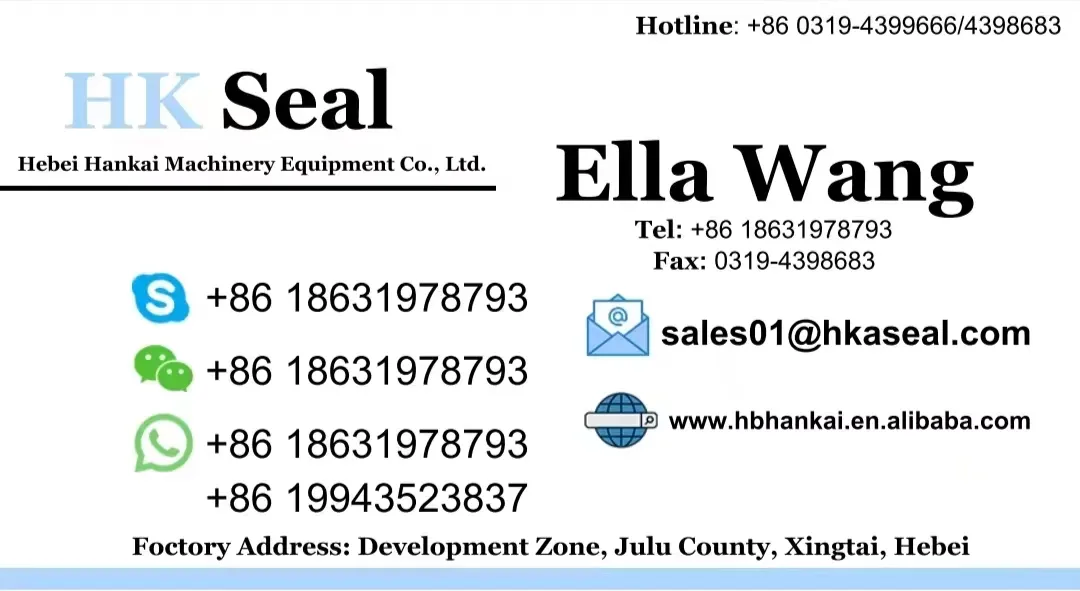Oct . 22, 2024 02:12 Back to list
High-performance hydraulic shaft seals for extreme pressure applications and optimal efficiency
High Pressure Hydraulic Shaft Seals Essential Components for Fluid Power Systems
In the realm of fluid power systems, high pressure hydraulic shaft seals play a crucial role in ensuring the efficiency and longevity of hydraulic machinery. These seals are engineered to prevent fluid leakage between the rotating shaft and stationary housing, which is paramount in maintaining system pressure and functionality. Understanding the importance, types, and maintenance of these seals can significantly enhance the performance and reliability of hydraulic systems.
Understanding Hydraulic Shaft Seals
Hydraulic shaft seals are designed to contain hydraulic fluids under varying pressures while allowing the shaft to rotate freely. When hydraulic systems operate, hydraulic fluid is pressurized and directed to various components, such as cylinders and motors, enabling them to perform their intended tasks. However, without effective sealing solutions, fluid can escape, leading to system inefficiencies, reduced performance, and potentially dangerous situations.
The significance of high pressure hydraulic shaft seals becomes evident when considering the extreme conditions under which many hydraulic systems operate. These systems often encounter pressures exceeding 5000 psi, temperature fluctuations, and exposure to different chemicals. Therefore, the selection of the right seal material and design is critical to ensure optimal performance in such challenging environments.
Types of High Pressure Hydraulic Shaft Seals
High pressure hydraulic shaft seals come in various designs and materials to suit different applications. Common types include
1. O-Ring Seals Simple yet effective, O-ring seals are widely used due to their versatility and ease of installation. They work well in dynamic applications and can handle moderate pressures effectively.
2. Lip Seals These seals feature a flexible lip that presses against the shaft, creating a robust barrier against fluid leakage. They are particularly effective in high-pressure environments and can handle dirt and contaminants, making them ideal for heavy-duty machinery.
3. Mechanical Seals Typically used in rotary applications, mechanical seals provide a reliable sealing solution under high pressure. They consist of two flat surfaces that create a seal, offering excellent pressure resistance and minimizing wear.
4. Cylindrical Seals Designed for high-pressure situations, cylindrical seals use a unique design to provide a tighter seal around the shaft. Their ability to manage high differential pressures makes them suitable for demanding applications.
high pressure hydraulic shaft seals

Material Considerations
The materials used in high pressure hydraulic shaft seals are paramount in ensuring their effectiveness. Common materials include
- Nitrile Rubber (NBR) Known for its excellent abrasion resistance and flexibility, NBR is a popular choice for many hydraulic applications.
- Fluoroelastomer (FKM) This material is highly resistant to heat and chemicals, making it suitable for high-temperature applications and aggressive fluids.
- Polyurethane (PU) Offering superior wear resistance, PU seals are ideal for dynamic applications, particularly in high-pressure hydraulic systems.
- PTFE (Polytetrafluoroethylene) Known for its exceptional chemical resistance and low friction properties, PTFE seals are used in applications where extreme conditions are expected.
Maintenance and Replacement
To ensure the longevity and reliability of hydraulic shaft seals, regular maintenance is essential. Operators should monitor seals for signs of wear or damage, such as fluid leakage or abnormal noises during operation. Regular inspection and replacement of seals at recommended intervals can prevent costly downtime and extensive repair work.
Additionally, maintaining optimal working conditions—such as avoiding exposure to incompatible fluids and excessive temperatures—can significantly extend the lifespan of hydraulic shaft seals.
Conclusion
High pressure hydraulic shaft seals are vital components within hydraulic systems, providing essential support for performance and safety. By understanding the various types of seals, material properties, and maintenance strategies, engineers and operators can enhance the reliability of their hydraulic systems, ultimately contributing to improved efficiency and reduced operational costs. As hydraulic technology continues to evolve, the development of advanced sealing solutions will play a critical role in driving innovation across various industries.
-
Unlocking the Potential of Hydraulic Systems with Essential Sealing Solutions
NewsAug.06,2025
-
Unleash the Power of Your Hydraulic Systems with Our Premium Seal Kits
NewsAug.06,2025
-
Specialized Hydraulic Seal Kits for Breakers, Pistons, and Presses
NewsAug.06,2025
-
Revitalize Hydraulic Systems with Premium Repair and Seal Kits
NewsAug.06,2025
-
Fortify Your Cylinders with Premium Sealing Solutions
NewsAug.06,2025
-
Elevate Hydraulic System Reliability with Specialized Seal Kits
NewsAug.06,2025
-
TCN Oil Seal Metal Ring Reinforcement for Heavy Machinery
NewsJul.25,2025
Products categories
















